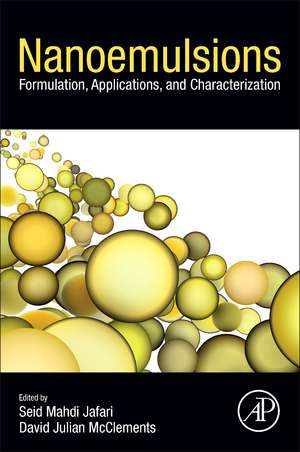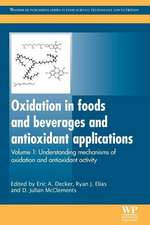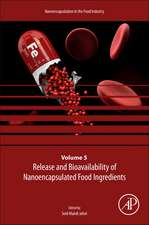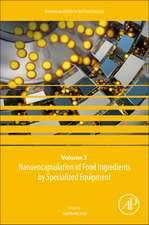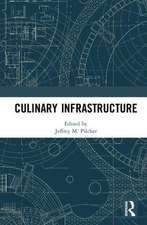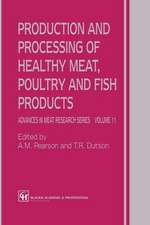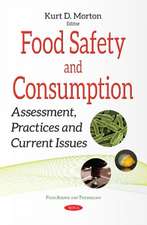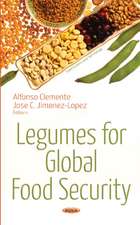Nanoemulsions: Formulation, Applications, and Characterization
Editat de Seid Mahdi Jafari, D. Julian McClementsen Limba Engleză Paperback – 5 mar 2018
- Summarizes general aspects of food nanoemulsions and their formulation
- Provides detailed information on the production, application, and characterization of food nanoemulsion
- Reveals the potential of nanoemulsions, as well as their novel applications in functional foods, nutraceutical products, delivery systems, and cosmetic formulations
- Explains preparation of nanoemulsions by both low- and high-energy methods
Preț: 917.81 lei
Preț vechi: 1015.39 lei
-10% Nou
Puncte Express: 1377
Preț estimativ în valută:
175.65€ • 182.70$ • 145.01£
175.65€ • 182.70$ • 145.01£
Carte tipărită la comandă
Livrare economică 07-21 aprilie
Preluare comenzi: 021 569.72.76
Specificații
ISBN-13: 9780128118382
ISBN-10: 0128118385
Pagini: 664
Dimensiuni: 152 x 229 x 36 mm
Greutate: 0.88 kg
Editura: ELSEVIER SCIENCE
ISBN-10: 0128118385
Pagini: 664
Dimensiuni: 152 x 229 x 36 mm
Greutate: 0.88 kg
Editura: ELSEVIER SCIENCE
Public țintă
Researchers in the nanoemulsion technology food science field; scientists from industry, academia, and governmental agencies; and policy makers on food science and nutrition, food engineering, chemical engineering, pharmaceuticals, chemistry, physical chemistry, and bioscienceCuprins
Section 1: Nanoemulsion basics
1. General aspects of nanoemulsions and their formulation
2. Nanoemulsion properties
Section 2: Preparation of nanoemulsions by low-energy methods
3. Catastrophic phase inversion techniques
4. Transitional phase inversion techniques
Section 3: Production of nanoemulsions by mechanical methods
5. General principles of nanoemulsion formation by high-energy mechanical methods
6. Fabrication of nanoemulsions by rotor-stator emulsification
7. Fabrication of nanoemulsions by high pressure valve homogenization
8. Fabrication of nanoemulsions by microfluidization
9. Fabrication of nanoemulsions by ultrasonication
10. Fabrication of nanoemulsions using membrane emulsification
Section 4: Application of nanoemulsions
11. Application of nanoemulsions in foods
12. Application of nanoemulsions in chemicals, agrochemicals, and petrochemicals
13. Application of nanoemulsions in drug delivery
14. Application of nanoemulsions in cosmetics
15. Application of nanoemulsions in synthesis of nanoparticles
Section 5: Characterization and analysis of nanoemulsions
16. Characterization of particle properties in nanoemulsions
17. Characterization of physicochemical properties of nanoemulsions
18. Characterization of gastrointestinal fate of nanoemulsions
Section 6: Conclusion, future trends, and regulatory issues of nanoemulsions
1. General aspects of nanoemulsions and their formulation
2. Nanoemulsion properties
Section 2: Preparation of nanoemulsions by low-energy methods
3. Catastrophic phase inversion techniques
4. Transitional phase inversion techniques
Section 3: Production of nanoemulsions by mechanical methods
5. General principles of nanoemulsion formation by high-energy mechanical methods
6. Fabrication of nanoemulsions by rotor-stator emulsification
7. Fabrication of nanoemulsions by high pressure valve homogenization
8. Fabrication of nanoemulsions by microfluidization
9. Fabrication of nanoemulsions by ultrasonication
10. Fabrication of nanoemulsions using membrane emulsification
Section 4: Application of nanoemulsions
11. Application of nanoemulsions in foods
12. Application of nanoemulsions in chemicals, agrochemicals, and petrochemicals
13. Application of nanoemulsions in drug delivery
14. Application of nanoemulsions in cosmetics
15. Application of nanoemulsions in synthesis of nanoparticles
Section 5: Characterization and analysis of nanoemulsions
16. Characterization of particle properties in nanoemulsions
17. Characterization of physicochemical properties of nanoemulsions
18. Characterization of gastrointestinal fate of nanoemulsions
Section 6: Conclusion, future trends, and regulatory issues of nanoemulsions
